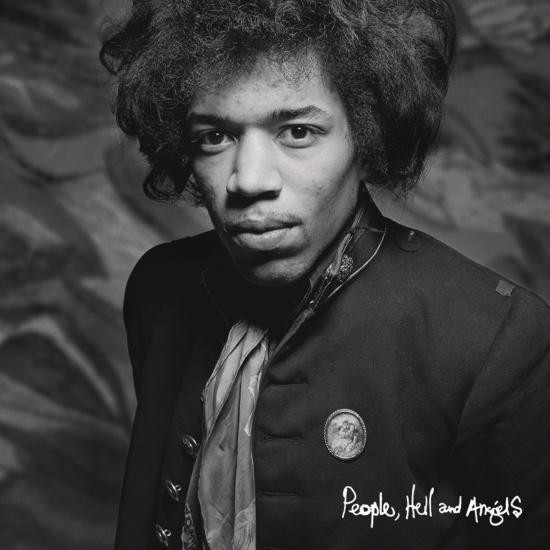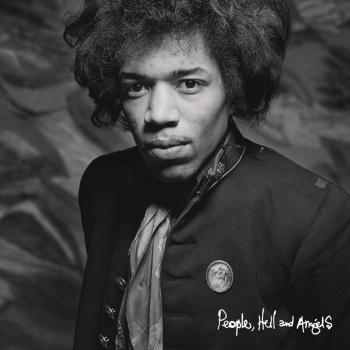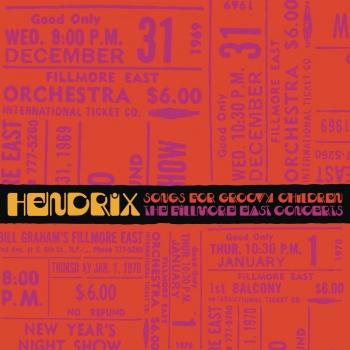
People, Hell & Angels (Remastered) Jimi Hendrix
Album Info
Album Veröffentlichung:
2013
HRA-Veröffentlichung:
01.02.2018
Das Album enthält Albumcover
Entschuldigen Sie bitte!
Sehr geehrter HIGHRESAUDIO Besucher,
leider kann das Album zurzeit aufgrund von Länder- und Lizenzbeschränkungen nicht gekauft werden oder uns liegt der offizielle Veröffentlichungstermin für Ihr Land noch nicht vor. Wir aktualisieren unsere Veröffentlichungstermine ein- bis zweimal die Woche. Bitte schauen Sie ab und zu mal wieder rein.
Wir empfehlen Ihnen das Album auf Ihre Merkliste zu setzen.
Wir bedanken uns für Ihr Verständnis und Ihre Geduld.
Ihr, HIGHRESAUDIO
- 1Earth Blues03:34
- 2Somewhere04:06
- 3Hear My Train a Comin'05:42
- 4Bleeding Heart03:58
- 5Let Me Move You06:50
- 6Izabella03:43
- 7Easy Blues05:57
- 8Crash Landing04:15
- 9Inside Out05:04
- 10Hey Gypsy Boy03:39
- 11Mojo Man04:07
- 12Villanova Junction Blues01:48
Info zu People, Hell & Angels (Remastered)
Experience Hendrix LLC und Legacy Recordings, eine Abteilung von Sony Music Entertainment, kündigen den Release von People, Hell & Angels an. Dieses neue Album enthält 12 bisher unveröffentlichte Studioaufnahmen der Gitarrenlegende Jimi Hendrix.
1968 war Hendrix auf der Suche nach neuen musikalischen Ausdrucksmöglichkeiten. Während seine Experience mit zwei Alben in den US Top Ten vertreten und zu einem der begehrtesten Live-Acts avanciert war, arbeitete er hinter den Kulissen mit alten Freunden und unterschiedlichen Besetzungen an neuen Songs. Auf People, Hell & Angels erhält der Hendrix-Fan erstmals einen hochinteressanten Einblick in diese Schaffensphase des Ausnahmegitarristen.
Die zwölf Songs des Albums zeigen, mit welcher Experimentierfreudigkeit der Musiker ans Werk ging. Neue Sounds und musikalische Stilrichtungen wurden ausprobiert, dabei kamen viele für Hendrix untypische Instrumente zum Einsatz: Bläser, Keyboards, Percussion und sogar eine zweite Gitarre.
People, Hell & Angels beweist auch, dass Jimi auf der Suche nach neuen Begleitmusikern war, mit deren Unterstützung er ein weiteres Kapitel in seiner außergewöhnlichen Karriere aufschlagen wollte. Anstatt auf seine Experience-Mitstreiter zurückzugreifen, arbeitete er mit Stephen Stills von Buffalo Springfield, dem Drummer Buddy Miles und dem Bassisten Billy Cox. Hendrix und Cox hatten ihren Militärdienst zusammen absolviert und waren in den frühen 1960ern Bandkollegen gewesen.
Jimis Schwester Janie Hendrix, Eddie Kramer und John McDermott fungierten als Koproduzenten von People, Hell & Angels. Kramer und Hendrix lernten sich im Januar 1967 in den Londoner Olympic Studios kennen und zwischen den beiden entstand eine intensive Beziehung. Schließlich wurde Eddie zu Jimis Lieblings-Tonmann, der jedes Album, das der Gitarrist zu Lebzeiten veröffentlichte, abmischte. Auch bei den Live-Aufnahmen des Woodstock-Festivals saß Eddie an den Reglern. Seit 1997 gehört er wieder zum Hendrix-Team und überwacht alle Releases von Experience Hendrix LLC.
Folgende bisher unveröffentlichte Hendrix-Tracks sind auf People, Hell & Angels zu hören: „Earth Blues“, „Somewhere“, „Hear My Train A Comin'“, „Bleeding Heart“, „Baby Let Me Move You“, „Izabella“, „Easy Blues“, „Crash Landing“, „Inside Out“, „Hey Gypsy Boy“, „Mojo Man“ und „Villanova Junction Blues“.
People, Hell & Angels ist der Nachfolger des 2010 erschienenen Valleys Of Neptune. Während sich dieses von der Kritik gefeierte Album den letzten Aufnahmen der Original-Jimi Hendrix Experience widmete, bietet People, Hell & Angels einen spannenden Einblick in Jimis musikalische Zukunftspläne. Hier wird ganz deutlich: mit dem als Nachfolger für Electric Ladyland geplanten Doppelalbum First Rays Of The New Rising Sun wollte Hendrix einen Stilwechsel vollziehen.
Anders als viele zeitgenössische Künstler wie die Beatles oder Bob Dylan, hatte Jimi Hendrix die Rechte an seinen Songs nie abgetreten. Er war also nicht an bestimmte Tonstudios gebunden, die von seiner Plattenfirma betrieben wurden. So verbrachte er Stunden und Tage in den Aufnahmeräumen von Record Plant oder Hit Factory in New York, um an seinem Sound zu feilen. Wegen seiner Leidenschaft für die Studioarbeit trieb Hendrix den Bau seines eigenen Electric Lady Studios voran. Während er an den Songs arbeitete, die auf People, Hell & Angels versammelt sind, entstand in Greenwich Village dieser topmoderne Komplex, in dem bis heute namhafte Künstler ihre Alben aufnehmen.
Janie L. Hendrix, President / CEO von Experience Hendrix LLC, sagt über People, Hell & Angels : „Mit dem Release des Longplayers erinnern wir an den 70. Geburtstag meines Bruders. Die brillanten Aufnahmen unterstreichen, dass Jimis musikalische Energie bis heute unübertroffen ist. Er wird noch viele Generationen nach der unseren inspirieren … und das wird wohl ewig so weitergehen.“
Auch Adam Block, President von Legacy Recordings, ist begeistert:„People, Hell & Angels gewährt dem Hörer weitere Einblicke in das Werk dieses genialen Gitarristen, der hier durch seine Arbeit mit veränderter Rhythmussektion und Instrumentierung neue, endlos scheinende musikalische Horizonte erschließt.“
Recorded March 1968 – August 1970 at Record Plant, Hit Factory, Sound Centre, Electric Lady; New York City; Fame, Muscle Shoals, Alabama
Produced by Jimi Hendrix, Eddie Kramer, Janie Hendrix, John McDermott
Digitally remastered
 Jimi Hendrix
Jimi Hendrix
Widely recognized as one of the most creative and influential musicians of the 20th century, Jimi Hendrix pioneered the explosive possibilities of the electric guitar. Hendrix's innovative style of combining fuzz, feedback and controlled distortion created a new musical form. Because he was unable to read or write music, it is nothing short of remarkable that Jimi Hendrix's meteoric rise in the music took place in just four short years. His musical language continues to influence a host of modern musicians, from George Clinton to Miles Davis, and Steve Vai to Jonny Lang.
Jimi Hendrix, born Johnny Allen Hendrix at 10:15 a.m. on November 27, 1942, at Seattle's King County Hospital, was later renamed James Marshall by his father, James 'Al' Hendrix. Young Jimmy (as he was referred to at the time) took an interest in music, drawing influence from virtually every major artist at the time, including B.B. King, Muddy Waters, Howlin' Wolf, Buddy Holly, and Robert Johnson. Entirely self-taught, Jimmy's inability to read music made him concentrate even harder on the music he heard.
Al took notice of Jimmy's interest in the guitar, recalling, 'I used to have Jimmy clean up the bedroom all the time while I was gone, and when I would come home I would find a lot of broom straws around the foot of the bed. I'd say to him, `Well didn't you sweep up the floor?' and he'd say, `Oh yeah,' he did. But I'd find out later that he used to be sitting at the end of the bed there and strumming the broom like he was playing a guitar.' Al found an old one-string ukulele, which he gave to Jimmy to play a huge improvement over the broom.
By the summer of 1958, Al had purchased Jimmy a five-dollar, second-hand acoustic guitar from one of his friends. Shortly thereafter, Jimmy joined his first band, The Velvetones. After a three-month stint with the group, Jimmy left to pursue his own interests. The following summer, Al purchased Jimmy his first electric guitar, a Supro Ozark 1560S; Jimi used it when he joined The Rocking Kings.
In 1961, Jimmy left home to enlist in the United States Army and in November 1962 earned the right to wear the 'Screaming Eagles' patch for the paratroop division. While stationed at Fort Campbell, Kentucky, Jimmy formed The King Casuals with bassist Billy Cox. After being discharged due to an injury he received during a parachute jump, Jimmy began working as a session guitarist under the name Jimmy James. By the end of 1965, Jimmy had played with several marquee acts, including Ike and Tina Turner, Sam Cooke, the Isley Brothers, and Little Richard. Jimmy parted ways with Little Richard to form his own band, Jimmy James and the Blue Flames, shedding the role of back-line guitarist for the spotlight of lead guitar.
Throughout the latter half of 1965, and into the first part of 1966, Jimmy played the rounds of smaller venues throughout Greenwich Village, catching up with Animals' bassist Chas Chandler during a July performance at Cafe Wha? Chandler was impressed with Jimmy's performance and returned again in September 1966 to sign Hendrix to an agreement that would have him move to London to form a new band.
Switching gears from bass player to manager, Chandler's first task was to change Hendrix's name to 'Jimi.' Featuring drummer Mitch Mitchell and bassist Noel Redding, the newly formed Jimi Hendrix Experience quickly became the talk of London in the fall of 1966.
The Experience's first single, 'Hey Joe,' spent ten weeks on the UK charts, topping out at spot No. 6 in early 1967. The debut single was quickly followed by the release of a full-length album Are You Experienced, a psychedelic musical compilation featuring anthems of a generation. Are You Experienced has remained one of the most popular rock albums of all time, featuring tracks like 'Purple Haze,' 'The Wind Cries Mary,' 'Foxey Lady,' 'Fire,' and 'Are You Experienced?'
Although Hendrix experienced overwhelming success in Britain, it wasn't until he returned to America in June 1967 that he ignited the crowd at the Monterey International Pop Festival with his incendiary performance of 'Wild Thing.' Literally overnight, The Jimi Hendrix Experience became one of most popular and highest grossing touring acts in the world.
Hendrix followed Are You Experienced with Axis: Bold As Love. By 1968, Hendrix had taken greater control over the direction of his music; he spent considerable time working the consoles in the studio, with each turn of a knob or flick of the switch bringing clarity to his vision.
Back in America, Jimi Hendrix built his own recording studio, Electric Lady Studios in New York City. The name of this project became the basis for his most demanding musical release, a two LP collection, Electric Ladyland. Throughout 1968, the demands of touring and studio work took its toll on the group and in 1969 the Experience disbanded.
The summer of 1969 brought emotional and musical growth to Jimi Hendrix. In playing the Woodstock Music & Art Fair in August 1969, Jimi joined forces with an eclectic ensemble called Gypsy Sun & Rainbows featuring Jimi Hendrix, Mitch Mitchell, Billy Cox, Juma Sultan, and Jerry Velez. The Woodstock performance was highlighted by the renegade version of 'Star Spangled Banner,' which brought the mud-soaked audience to a frenzy.
Nineteen sixty-nine also brought about a new and defining collaboration featuring Jimi Hendrix on guitar, bassist Billy Cox and Electric Flag drummer Buddy Miles. Performing as the Band of Gypsys, this trio launched a series of four New Year's performances on December 31, 1969 and January 1, 1970. Highlights from these performances were compiled and later released on the quintessential Band of Gypsys album in mid-1970 and the expanded Hendrix: Live At The Fillmore East in 1999.
As 1970 progressed, Jimi brought back drummer Mitch Mitchell to the group and together with Billy Cox on bass, this new trio once again formed The Jimi Hendrix Experience. In the studio, the group recorded several tracks for another two LP set, tentatively titled First Rays Of The New Rising Sun. Unfortunately, Hendrix was unable to see this musical vision through to completion due to his hectic worldwide touring schedules, then tragic death on September 18, 1970. Fortunately, the recordings Hendrix slated for release on the album were finally issued through the support of his family and original studio engineer Eddie Kramer on the 1997 release First Rays Of The New Rising Sun.
From demo recordings to finished masters, Jimi Hendrix generated an amazing collection of songs over the course of his short career. The music of Jimi Hendrix embraced the influences of blues, ballads, rock, R&B, and jazz a collection of styles that continue to make Hendrix one of the most popular figures in the history of rock music. (Source: Sony)
Dieses Album enthält kein Booklet












